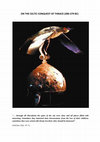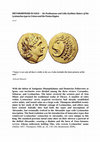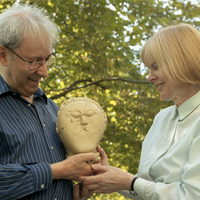Papers by Brendan Mac Gonagle

Balkan Celts
… through all Macedonia the gates of the city were shut, and all places filled with mourning. Som... more … through all Macedonia the gates of the city were shut, and all places filled with mourning. Sometimes they lamented their bereavement, from the loss of their children; sometimes they were seized with dread, lest their cities should be destroyed". (Justinus, Epit. 24: 5) Until recently our knowledge of the events surrounding the Celtic migration into southeastern Europe at the beginning of the 3 rd century BC has relied exclusively on Greek and Roman 'histories', with little or no reference to modern archaeological evidence which supplements and, in many cases, contradicts these accounts. However, over the past decades a wealth of new archaeological data from the region concerned finally allows us to furnish a more accurate picture of events surrounding this dramatic episode in European history (on the precise dating of these events see :344, 410, Petzl 1984:141-142, Boardman et al 1986, Šašel Kos 2005:189-196, Walbank et al 2006. From the mid 4 th century BC the Thracian interior gradually fell under the control of the Macedonian Empire. This was largely achieved through the Thraco-Macedonian Odrysae tribe whose rulers, notably Seuthes III, governed Thrace as de facto puppet kings controlled by Macedonia (see below). The same tribe would later perform a similar function for Rome in the late 1 st c. BC/early 1 st c. AD. Bronze head discovered near the entrance of the Golyama Kosmatka Tumulus near Seuthopolis, part of a life-size statue thought to be of Seuthes III. (National Archaeological Museum, Sofia; see Mac Gonagle 2013) Ritually 'killed' Macedonian helmet from a Celtic warrior burial at Sevtopolis (after Getov 1962) Spatial distribution of Celtic (La Têne) brooches in Seuthopolis (marked with B (bilateral fibulae). (After Emilov 2010)
The article provides an overview of the available linguistic, numismatic and archaeological evide... more The article provides an overview of the available linguistic, numismatic and archaeological evidence pertaining to the expansion of the La Tene culture into the area of modern Ukraine and the North Pontic region from the 3rd century BC onwards. A distinction is observed between the situation in western Ukraine where the process of Celtic migration — colonization is reflected in the archaeological evidence, and further east where the presence of Celtic “warrior bands” — mercenary groups have been identified. The testimony in ancient sources to the emergence of mixed Celto-Scythian populations in this area is also considered.
On the Celtic Coralli tribe in Ancient Thrace
The emergence of the first European (non-classical) coinage has hitherto been explained by a vagu... more The emergence of the first European (non-classical) coinage has hitherto been explained by a vague and unsupported theory that it emerged 'somewhere in Central Europe' after 275 BC, based on Macedonian issues brought back by Celtic mercenaries. However, recent archaeological / numismatic evidence from Eastern Europe has seriously undermined this oft repeated but unsubstantiated theory, and finally provided some scientific clarity on the chronology of this phenomenon, as well as furnishing surprising information regarding the motivation behind the first Celtic coinage.
One of the most sensational discoveries of the Viking Age, the ship burial uncovered in a tumulus... more One of the most sensational discoveries of the Viking Age, the ship burial uncovered in a tumulus or haugr at Oseberg farm near Tønsberg in Vestfold county, Norway at the beginning of the 20 th century consisted of an astonishingly well-preserved Viking ship containing the remains of two women along with a wide variety of associated burial goods.
Celtic Coinage and Coin Hoards from Bulgaria
Balkan Celts, 2019
Celtic Dragon-Pair Scabbards
Some of the most exquisite European Iron Age jewelry pieces were produced by the " barbarian " tr... more Some of the most exquisite European Iron Age jewelry pieces were produced by the " barbarian " tribes on the Balkan peninsula between the 4 th and 1 st century BC. During this period Celtic craftsmen, working in a variety of mediums, drew heavily on both Scythian and Hellenistic art; a process which culminated in a distinctive Balkan Celtic style. Although multiple mediums were used, the genius of Celtic craftsmen of this period is to be most clearly observed in silver treasures produced by the Scordisci tribes, such as those from Hrtkovci, Židovar, Čurug etc.
The Roman Limes on the Lower Danube – a sophisticated and highly developed defensive and communic... more The Roman Limes on the Lower Danube – a sophisticated and highly developed defensive and communication network which bears testimony to the magnificent planning and organizational skills of Imperial Rome. Or was it? In fact, recent archaeological research in the Lower Danubian region (Croatia, Serbia, Bulgaria, Romania) clearly indicates that this network was not developed by Rome, but adopted from a previously established Iron Age network.
The Celtic chariot burial from the Mal Tepe tomb at Mezek in the Haskovo region of southern Bulga... more The Celtic chariot burial from the Mal Tepe tomb at Mezek in the Haskovo region of southern Bulgaria is one of the most significant Celtic finds from the Balkans, in terms of the artifacts themselves, and the nature and chronology of the burial. However, from the outset the site has also been a prime example of the ugliest aspects of archaeology on the Balkans.

Balkancelts
In the year 202 AD an inscription (IGBulg. III, 2 # 1690) was carved at the newly founded Έμπόριο... more In the year 202 AD an inscription (IGBulg. III, 2 # 1690) was carved at the newly founded Έμπόριον (emporion/market) at Pizos (Stara Zagora region) in the heart of Thrace (Tab. Peut. 18, col. 528-540 (Ranilum XXV -Pizo XII -Arzum XIX); ItAnt 136, 6 (Cillis m.p. XXXI -Pizo m.p. XX -Arso m.p. XVIII); Procop. Aed. 4.11.15 /146.12/ (Πίνζος). The inscription represents, along with the Carasura inscription -found 15 km. to the north (see Mac Congail 2008), the most valuable record of Thracian personal names from this period. The Pizos inscription is composed of the following 17 double component 'Thracian' names: Apollini et Sironae Biturix Iulli f(ilius) d(onavit) = 'To Apollo and Sirona, Biturix, son of Jullus offered (this altar)'. Biturix, composed of bitu-, 'world' and -rix, 'king', is a common Celtic name meaning 'King of the World'. (Delamarre 2003: pp. 76-77, 259-260). The Biturix inscription from Tranqueville-Graux. Musée d'Epinal (Vosges) Also in insular Celtic names. Cf.: Bitu[cus] (Catterick, N. Yorkshire -RIB II 2501.107); Bitupr[…] (Chesters, Northumberland -RIB II 2501.105); Bitucus (Cirencester, Gloucestershire -RIB I 108 = Duo Nomina -Fl[au]ius Biticus); Bitudacus (Leicester, dated AD 45-65 -RIB II 2501.108); Bitu[…] (York -RIB II 2494.111). Further: Διας-= (Celtic) Dias A common Celtic element in personal names. Cf. Diastus from Gaul (Aguilée -CIL 05 1169), Diastumarus from Slovania (Trojane -CIL 3 11683), Diassumarus from Hungary (Dunaujvaros -AE 1906 117), Diasulos, etc. (see also Mac Congail 2008:156). Δαλη-= (Celtic) Dali, Dala, Dalus, etc. The 'Thracian' name Δαλη-/Δαλα-etc. has long been linked to the continental Celtic personal names Dali, Dala, etc. (Holder AC I: 1217; Detschew op cit 114; Mac Congail 2008:144-146). -πορις = (Continental Celtic) Porios, Porius etc. (Holder ACII: 1037; Mac Congail 2008) (Insular Celtic) Porius (Mac Congail,loc cit) Further: -κενθος = (Celtic) Cintus, Κιντος, etc. One of the most common 'Thracian' name elements (Georgiev 1977: 84). Compare the Celtic names Κιντος, Cintetra, in Thrace (Detschew, 1957:240; Holder ACI 989), Cinturetus in Galatia (Pliny, Natural History, VIII, 64), Cintugenus -from Bordeaux (CIL 13672), Budapest (CIL 03 12014) and Bad Deutsch Altenburg (CIL 3 12014), Cintusmia -Dijon (CIL 13 5484), Cintulus -Austria, Maria Sall (CIL 3 4934), etc. -ζενις = (Celtic) -genus/-gnos, etc.
Some of the most fascinating archaeological discoveries in recent years have come from the Bronze... more Some of the most fascinating archaeological discoveries in recent years have come from the Bronze and Iron Age site at Cliffs End Farm on the Isle of Thanet (Kent), in southeastern England. Of the wealth of material uncovered at the site most enigmatic is pit #3666, which tells a tale of bizarre ritual practices and human sacrifice.,,
The most spectacular and enigmatic of Celtic coinage, the gold ‘rolltier’ staters emerge among th... more The most spectacular and enigmatic of Celtic coinage, the gold ‘rolltier’ staters emerge among the Celtic tribes in the area of southern Germany and Bohemia in the late 2nd/ 1st c. BC.
In order to explore the origin and significance of Samhain, the Celtic " Festival of the Dead " ,... more In order to explore the origin and significance of Samhain, the Celtic " Festival of the Dead " , it is necessary that it be viewed in the context of the wider Celtic belief system, the central tenet of which was metempsychosis – the transmigration of the soul and its reincarnation after death.
in Veliko Tarnovo (n.e. Bulgaria), and Zaravetz Lead and Bronze Coinage 3/12/2016 " Who can I rec... more in Veliko Tarnovo (n.e. Bulgaria), and Zaravetz Lead and Bronze Coinage 3/12/2016 " Who can I recite my work to here, but yellow-haired Coralli, and the other tribes of the barbarous Danube? " (Ovid, Ex Ponto. Book EIV.II To Cornelius Severus: A Fellow Poet) The Hill of Zaravets (Tsaravets; Bulgarian: Царевец) overlooks the town of Veliko Tarnovo in today " s northeastern Bulgaria. Situated on the strategically important Jantra river which links it to the Danube, Zaravetz is best known as the capital of the Second Bulgarian Kingdom during the medieval period, and has thus been the subject of extensive archaeological research. View of the Hill of Zaravetz today with (mostly reconstructed) remains of the medieval fortress
n.e. Bulgaria " The Gauls, who had been left behind by their general Brennus, when he marched int... more n.e. Bulgaria " The Gauls, who had been left behind by their general Brennus, when he marched into Greece, to defend the borders of their country, armed fifteen thousand foot and three thousand horse (that they alone might not seem idle), and … routed the forces of the Getae and Triballi… ". (Justinus, Prol. XXV,1) In the Sboryanovo Archaeological Reserve in northeastern Bulgaria are situated the remains of an ancient city which became the political and religious center of the powerful Thracian Getae tribe during the 4 th century BC. The most spectacular of a number of ancient tombs at the site, which has been identified by Bulgarian archaeologists as " Dausdava " – The City of Wolves, mentioned in Tabula Nona of the Roman geographer KL. Ptolemaios, is the UNESCO listed Sveshtarska Grobnitsa (Sveshtari Tomb)

With the defeat of Antigonus Monopthalmus and Demetrius Poliorcetes at Ipsus, vast territories we... more With the defeat of Antigonus Monopthalmus and Demetrius Poliorcetes at Ipsus, vast territories were divided among the three victors: Cassander, Seleucus, and Lysimachus. The latter received the western part of Asia Minor and retained his traditional realm of Thrace. A number of cities within Lysimachus' newly acquired territories had already established active mints, and issued coins on a large scale. Thompson identified twenty mints in her study of the lifetime coinage of Lysimachus, and others may have existed. Initially they had both the types and inscriptions of Alexander, but eventually evolved to the Alexander type with Lysimachus inscription. The final evolution was his introduction of innovative types that reinforced Lysimachus' connection to Alexander, yet were unique to this king. His standard precious metal coins show on their obverse a portrait of the deified Alexander, wearing a diadem and the horn of Zeus-Ammon; reverse Athena enthroned, holding Nike, who crowns Lysimachus' name
After more than half a century of complete academic silence, the past few years have witnessed th... more After more than half a century of complete academic silence, the past few years have witnessed the miraculous (re)discovery of numerous hoards of Celtic coins from the Republic of Bulgaria. This phenomenon is particularly remarkable in the Rousse area, which has hitherto yielded the highest concentration of such numismatic material, leading Bulgarian experts to conclude that, "The line from Rousse to Veliko Tarnovo, mostly along the Jantra and Russenski Lom rivers, is the central axis of this type of Celtic coinage, respectively the Celtic tribal state/organization that produced it" (Paunov 2013).
While communist regimes on the Balkans may have fallen almost three decades ago, the legacy of po... more While communist regimes on the Balkans may have fallen almost three decades ago, the legacy of political manipulation during that dark period in European history continues to undermine and distort archaeological research in the region.











Uploads
Papers by Brendan Mac Gonagle